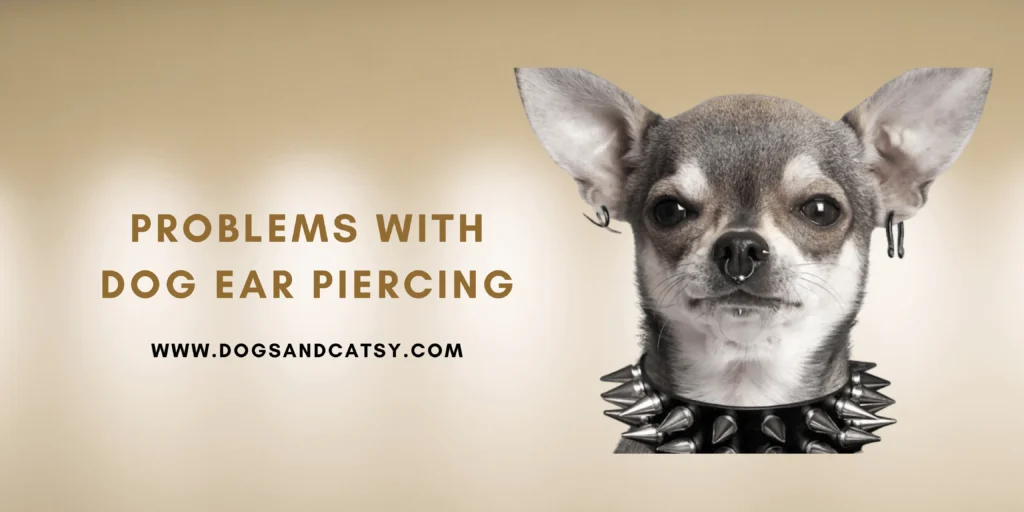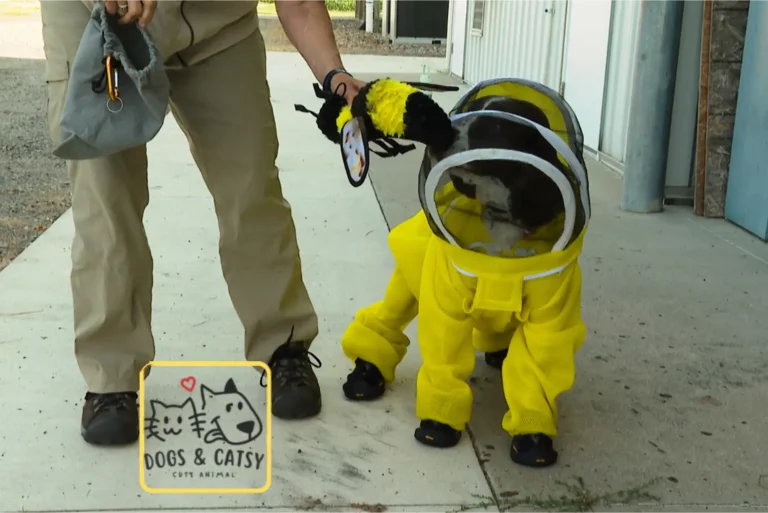Dog Ear Piercing: Learn What Vets Say!

Dog ear piercings are not just a fashion statement; they’re a controversial practice that can harm your furry friend. Subjecting your dog to this unnecessary procedure can lead to pain, infection, and discomfort, overshadowing any aesthetic appeal. So you should not go for ear piercing for your Dog. Prioritizing your pet’s well-being over trends is the mark of a truly responsible and caring owner.
Dog Ear Piercing
Ear piercing in dogs entails the placement of ornamental items like earrings or studs through their earflaps or cartilage, a process defended by some as a harmless expression of individual style akin to that in human children. Nevertheless, the practice raises ethical concerns due to the animals’ inability to provide informed consent.
Why Do People Pierce Their Dogs’ Ears?
Some people think piercing a dog’s ears makes them look cool or different, but this idea doesn’t consider the possible pain or harm to the dog. Also, while a few may think piercings help identify their pet, safer and kinder options like microchipping and ID tags exist.
Can You Pierce Dogs Ears?
It’s important to understand that piercing a dog’s ears is highly discouraged. This practice is not only ethically questionable but can also pose significant risks to the dog’s health and emotional state.
Piercing can lead to discomfort, a higher chance of infections and other health issues, and may cause stress or anxiety in dogs. We should prioritize the well-being of our pets by avoiding unnecessary procedures that could harm them.
Legal Considerations: Is it illegal to pierce dog ears?
Animal Cruelty Laws
Ear piercing in dogs is widely regarded as a form of animal cruelty and is illegal in various regions. This action can lead to serious legal consequences.
For instance, in New York, someone found piercing a dog’s ears could face animal cruelty charges, which is a misdemeanor. This could result in up to one year in jail and a fine of up to $1,000.
In California, the law under Penal Code Section 597 categorizes the act of intentionally harming an animal, such as ear piercing that leads to mutilation, as a criminal offense.
Similarly, Texas law, under Penal Code 42.09, prohibits actions that harm animals, including dogs, outlining penalties for torture, poisoning, or causing unnecessary suffering.
It’s crucial to understand and respect these laws to protect the well-being of animals.
Animal Cruelty Laws by State:
- Florida’s statutes, specifically Title XLV, Chapter 828, detail offenses related to animal cruelty.
- In Massachusetts, the General Laws Chapter 272, Section 77, address cruelty towards animals.
- Illinois has the Humane Care for Animals Act (510 ILCS 70), setting forth the state’s regulations on this issue.
- Arizona’s laws on animal cruelty are found under ARS 13-2910.
Many other states have their own specific laws that categorize ear piercing in dogs as a form of mutilation.
Laws concerning animal cruelty differ across states. It’s crucial to be informed about the regulations in your region before considering any procedure like dog ear piercing. Generally, this act is considered unfavorable and can be seen as animal abuse, especially when done for cosmetic reasons.
Local Regulations
Besides state laws, local rules might also apply to dog ear piercing. For instance, certain cities and counties have specific rules that ban ear piercing for dogs.
Also read: Why do dogs like to be pet
What Are The Risks Of Piercing A Dog’s Ears?
Performing ear piercings on dogs can lead to numerous hazards and possible complications. Among the primary risks linked to this practice are:
Infections
Ear piercings in dogs can lead to open wounds that are prone to infections. When dogs scratch or touch their ears with their paws, they can transfer dirt and bacteria to the pierced area, raising the chance of an infection.
Signs of an infection in the ear include redness, swelling, discharge, and the area feeling unusually warm. If not addressed, the infection could spread and cause more severe health issues.
Infection Prevention Measures:
- Combat bacteria and manage infection risk
- Promote wound healing and alleviate discomfort
- Ensure sterilization to hasten recovery
- Use natural, safe, gentle, and appealing treatments
Allergic Reactions
Dogs can have allergic reactions to the materials in earrings, leading to irritation and other serious problems. Signs of an allergy include redness, swelling around the face and other areas, and itching.
In extreme cases, a dog might have trouble breathing. It’s crucial to watch for any allergic symptoms and get veterinary help right away if they occur.

Pain and Discomfort
Piercing a dog’s ears can inflict substantial pain and discomfort since dogs possess nerve endings in their ears. Throughout the procedure, dogs may exhibit distress signals like whining, whimpering, or attempting to retreat.
Hearing Loss
Piercing a dog’s ears can result in nerve damage within the ears, potentially causing hearing loss. Since dogs use their hearing to help and protect their owners, it’s important for responsible pet owners to avoid ear piercing, ensuring their dog’s life isn’t made harder by such unnecessary procedures.
Long-Term Health Effects
Piercing a dog’s ear can result in lasting health issues. Continuous irritation from the piercing can cause scar tissue to form, potentially leading to the ear’s deformation.
Moreover, ongoing pressure on the ear might cause persistent pain and discomfort. In certain instances, the piercing could harm the ear’s cartilage, resulting in permanent disfigurement.
Ethical Concerns
Thinking about piercing a dog’s ears brings up some serious ethical issues. People who support animal rights say changing how an animal looks for human tastes is wrong and not needed.
They think dogs should be free to look and act naturally, without people changing them. Piercing a dog’s ears is viewed as breaking their rights and as a type of animal cruelty.
Vets also worry about ear piercings for dogs. They say it can cause pain and discomfort that isn’t necessary for the pet.
It’s Straight-up Unnecessary
Putting dogs through cosmetic changes they don’t need, like ear piercing, leads to unnecessary discomfort. While some animals, like cows, might get piercings for practical reasons like identification, piercing a dog’s ears is only for looks and isn’t necessary at all.
Also read: German Shepherd Husky Mix
Other Dog Practices to Avoid
Painting Dog’s Nails
One of the most common and affordable trends in pet care, aside from ear piercing, is painting your dog’s nails. However, nail polish contains both solid and liquid ingredients, including potentially harmful substances like acetone, ethyl acetate, and formaldehyde.
Formaldehyde, in particular, is known to be carcinogenic. When applied to a dog’s nails, there’s a high risk the dog will ingest it either out of discomfort, curiosity, or during its normal behavior of licking its paws. This can easily lead to poisoning, with symptoms such as:
- Vomiting
- Diarrhea
- Drowsiness or weakness
- Loss of appetite
- Excessive drooling
- Difficulty breathing
- Tremors or seizures
- Uncoordinated movements
- Pale or yellowish gums
- Increased heart rate
If you think your dog has been poisoned, do not try to treat it yourself at home. Instead, contact your veterinarian or an emergency veterinary clinic immediately for guidance on what to do next. Quick action is crucial in cases of poisoning, so do not hesitate to seek professional assistance.

Dog Ear Tattoo
A tattoo is made by piercing the skin and putting permanent ink into it. People do this for different reasons, like getting a unique mark for identification, which can include a vet-given microchip, medical reasons, grooming, or just for enjoyment.
It’s technically possible to tattoo a dog, but it’s illegal in many places. Tattooing a dog’s ear, whether for identification or to make it look a certain way, is not needed and can hurt the dog.
Ear Cropping
Ear cropping is a surgery that changes the shape of a dog’s ears for looks. It means cutting part of the ear’s cartilage and then taping the ears to make them look a certain way.
This is done mostly for specific dog breeds to meet breed standards, but it’s a debated practice and illegal in many places because it can hurt and cause pain to the dog.
Tail Docking
Tail docking involves surgically cutting off part of a dog’s tail, often for appearance or to meet certain breed standards. Similar to ear cropping, this procedure is widely debated and has been made illegal in numerous areas due to the unnecessary pain it inflicts on the animal and the potential for health complications.
Alternatives to Piercing and Other Practices to Avoid
If you aim to enhance your dog’s style, there are alternative and safer methods to achieve this without causing harm to their body.
Stylish Collars and Leashes
Choose top-quality collars and leashes that are stylish and practical. You’ll find a wide range of designs and materials, including leather, fabric, or customized ones featuring your dog’s name or a special design.
You can also make your dog look trendy with fashionable bandanas or scarves. These come in many colors and patterns, letting you update your pet’s look for any event.
Non-Invasive Jewelry
For pet owners looking to style their dogs safely, non-invasive jewelry is a great alternative to piercing. This kind of jewelry doesn’t hurt the dog and comes in various types.
A popular choice is a collar decorated with charms or pendants that can be easily put on or taken off. This lets owners switch up their dog’s style as they like. Another option is a bandana or scarf that can be adorned with a decorative slide or clip.
Grooming Accessories
Maintaining your dog’s grooming can improve their overall appearance. You might want to explore fashionable grooming accessories such as bows, clips, sunglasses, or ribbons to add a stylish touch to their fur.
Creative Dog Haircuts
Certain dog breeds offer opportunities for creative grooming styles that are both fashionable and practical, such as poodle cuts or breed-specific grooming styles.
Also read: Can a dog get a cat pregnant?
Can You Tattoo A Dog?
Previously, before microchips became the norm for pet ID, dogs like German Shepherds were often tattooed on their ears for identification.
This method provided a permanent mark to help reunite lost or stolen dogs with their owners. Tattooing was common among working and service dogs, involving a unique code for each dog that could be linked back to the owner through databases.
By 2017, practices like these were largely phased out in favor of microchipping, as seen with the German Shepherd Society of Australia. It’s crucial to recognize that tattooing dogs for decorative reasons is widely seen as unethical and harmful, posing numerous risks to the animal’s well-being.
Here are some reasons why it is deemed unethical and a health risk:
- Pain and Distress: Tattooing causes discomfort and pain by piercing the skin with needles. It’s generally considered unethical to subject animals to unnecessary pain for non-medical purposes.
- Infection and Complications: There’s a risk of infection from tattooing if equipment is not properly sterilized. Using contaminated ink or equipment can cause bacterial or viral infections, along with possible allergic or adverse skin reactions.
- Anesthesia Risks: To tattoo a dog, restraint, and anesthesia are often needed to keep the animal still, which carries risks, particularly for older dogs or those with health issues.
- Long-term Implications: Tattoos can blur or distort over time due to changes in the dog’s skin, making identification difficult.
- Alternatives Available: Microchipping is now the preferred method for pet identification. It involves implanting a small electronic device under the dog’s skin, which can be scanned to access the owner’s information, offering a safe, permanent solution for reuniting lost pets with their owners.
FAQs
Can I Pierce My Dog’s Nose?
No, dogs cannot undergo nose piercing. This practice can result in significant pain, discomfort, and potential infections for the dog. Moreover, it may cause breathing difficulties and other health complications.
Are Magnetic Earrings for Dogs Okay?
It is advised against using magnetic earrings for dogs. These earrings can become detached or be readily dislodged by the dog, potentially resulting in ingestion. This ingestion poses a risk of gastrointestinal blockages or other related health concerns.
Is It Safe to Pierce A Dog’s Ears?
Piercing a dog’s ears poses risks and is not advisable. This procedure can lead to infections, cause pain, and discomfort, and potentially result in lasting harm to the ear cartilage. For these reasons, ear piercing for dogs is discouraged.
What are pointy dog ears called?
Erect ears, also known as pointy dog ears, are a trait found in certain dog breeds. These breeds naturally have upright ears, whereas others have floppy ears. Erect ears enhance a dog’s ability to hear and determine where sounds are coming from more effectively.
Do dogs like their ears touched?
Whether a dog likes having its ears touched varies with its personality and temperament. It’s important to pay attention to the dog’s body language and response when you touch their ears. If the dog seems uncomfortable or in pain, it’s better to stop and avoid touching their ears.
Are ears back on a dog good?
When a dog’s ears are pinned back, it could be a sign of fear, anxiety, or submission. Observing the dog’s overall body language and the situation is key to interpreting this behavior correctly. If the dog appears fearful or anxious, it’s advisable to give them space and avoid approaching.
Can you pierce a cat’s ear?
It is advised against piercing a cat’s ear since it can lead to infections, cause pain, and discomfort, and may even result in lasting harm to the ear cartilage. Overall, ear piercing is unnecessary for cats and can adversely affect their well-being.
Do dogs feel pain when you cut their ears?
Ear cropping can cause significant pain for dogs, particularly when done without proper anesthesia or pain management, often referred to as a ‘DIY’ procedure. Healing from this procedure can be lengthy, requiring extensive aftercare, including regular changes of dressings and cleaning, and there is a high risk of infection.
Can a dog have an earring?
Piercing a dog’s ears is neither safe nor harmless. While some dogs might seem to recover well from ear cropping and similar procedures, making it seem possible to safely pierce a dog’s ears, the real concern lies in the aftermath of the piercing process. The potential risks and complications that can arise afterward make it a dangerous practice.
Conclusion
Piercing a dog’s ears is a debated practice that poses ethical concerns regarding the welfare of dogs. Pet owners must put their dogs’ health and comfort first, rather than aesthetic preferences. Rather than exposing them to unnecessary procedures, we should aim to create a caring and supportive atmosphere. This approach respects their natural behaviors and limits, ensuring they remain happy and valued family members.






